Sri Lanka Journal
Days 1 and 2: Colombo

Hello and Ayobowan from lovely Sri Lanka! We had a rather efficient trip to Colombo, connecting in Heathrow and Doha, arriving a scant 24 hours after leaving home. The advantage of having a busy week right before leaving was that we were able to sleep through most of the trip. We arrived at the semi-standard hour of 3am, and as soon as we walked outside the airport were immediately enveloped in warm, humid air and the scents of flowers. Definitely a nice contrast to the feet of snow at home!
The tourism industry in Sri Lanka is growing at a rapid clip, and there are brand-new elegant hotels all through the country with many more to come to meet the burgeoning demand. Our hotel in Colombo was one of these, with an infinity swimming pool, a rooftop bar, and very elegant rooms with all the mod cons. Perhaps most important was the presence of excellent satellite TV that includes not just BBC and Star movies, but also Sony Six Live. The latter might not seem too important, unless of course it's 5am local, you've just checked in, and you realize that the Super Bowl just started. So we unpacked and showered while watching the Super Bowl live. As the sun rose, Katy Perry was dancing with sharks, which I admit I at first thought might be a sign of hallucination. We were going to take a nap, but that 4th quarter definitely woke us up! GO PATS!

Colombo is the economic capital of the country, and also has many of the government buildings. The "official" capital is on the outskirts of the city, but all the main ministries seem to be downtown. There is an old part of the city near the Dutch fort and the English residential areas, but even these neighborhoods are sprinkled with high-rises and modern buildings. The Galle Face Green is a smallish open park along the waterfront where people walk in the evening, enjoying the breeze. The first hotels in town are along the Green, including ours at the northern end. The commercial port is just north of the fort, so if you look north from the hotel you see big red cranes from the container docks, and the shipping lane runs right by the Green. There is an enormous amount of building going on throughout the city, although it doesn't seem very well organized. There are partially-built skyscrapers on every piece of land, everything from hotels (Grand Hyatt Colombo opening 2016) to commercial buildings (hi, Citibank) to mysterious complexes being built by the Chinese. Most interesting is a huge ""island city" being built on new fill just north of the Galle Face Green between there and the port. It is a huge Dubai-style fill complex that will have high rises, a commercial district, and apparently a Formula 1 racing circuit. This is just barely getting started, with a large pile of rocks and many cranes perched just in the sea. Our hotel must be annoyed, as their infinity pool that formerly looked out on the Indian Ocean now looks out on a somewhat less picturesque pile of boulders.
During our short stay in Colombo we went to the National Museum (under renovation), drove by the brand-new national theatre (gorgeous building in the shape of a lotus), and saw the Dutch Hospital (a cute tiled building recently turned into a shopping complex). Everywhere sites were under renovation, being converted to new uses, and generally cleaned up. It was incredibly impressive to see the development, but you do tend to question if there are any such things as "zoning laws" or if it's more of a free for all. The Chinese were winning the influence-by-FDI contest, but India was clearly making a move.
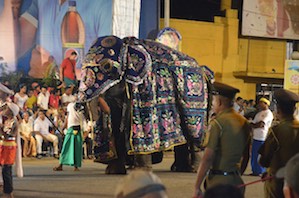
Sri Lanka is a majority Buddhist nation, and every full moon there is a poya day, a holiday. People fast during the day, there is no alcohol sold, and in the evening there is a festival. Not every temple holds a festival every month, but rather they take turns. About 20 years ago one of the big temples in Colombo started to have a big parade for the February poya day, and we were lucky to be in town for this event. The perahera is a two-hour long procession down the streets of the Pettah district not far from the fort. There were 100 dance groups from around the region, performing what seemed to be about 3 dances (the energetic cane dance, the promenading history dances with masked dancers, and some animal dances). These were interspersed with drummers and pipers creating a constant background of music. Domesticated elephants were brought in from across the region. They were draped in silks not unlike Mexican wrestlers and walked along between the bands and the dancers. Some walked quietly, but some clearly liked the drumming and started swaying to the music, swinging their trunks and stepping back and forth like gigantic swing dancers. At one point, a series of flatbed pickups sponsored by the Rotarcy (yes, Rotarcy) Club drove by with large Buddha statues mounted on the beds. The crowd stood as they drove by and threw small bills as donations. Right at the end of the parade were the stilt walkers and the dancers spinning firepots. There were even a few people spinning fire pots while walking on stilts. It was loud and joyful and there were dozens of elephants in sparkly silk drapings. Definitely better than our parades. Best of all there was a jumbotron flat screen TV on one of the buildings that showed the "behind the scenes" prep for the parade. The only thing missing was commentators.
Having enjoyed the parade and seen the hundreds of construction sites, it was time to leave Colombo and move into the center of the country to the cultural triangle, where we can find the historic capitals and many architectural sites. On our way out of town, we passed one of the festival elephants walking along the highway back to his home, his mahouts walking with him, silks now packed away.
As we left Colombo we heard that Boston was turning into Hoth. We thought of all our friends and their shoveling while we enjoyed the 88 degree weather and the freshly grown pineapple. :-)
Day 3: Dambulla
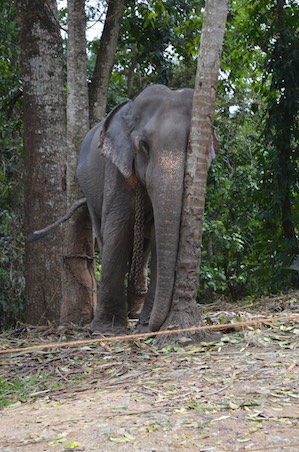
The travel theme of this day was pachyderms. These lovely animals are of course revered across Asia, and there is actually a Sri Lankan subspecies of the Asian elephant, a little bit smaller than the Indian version. Only a small fraction of the males are tuskers, unusual relative to the African elephants. Because they are smaller, smarter, and less wild, the Asian elephants are more easily domesticated to work or to become temple elephants.
Our drive to the central cultural triangle took 5-6 hours, prolonged due to the constant interruptions from road construction. The main highway is two lanes, often down to just one as repairs and widening are done. We broke our journey with a visit to the Millennium Elephant Foundation, a charity that rescues domesticated elephants who are ill or injured. This unfortunately does happen, and it's expensive to get an elephant veterinarian. Sometimes their injuries and malnutrition are not treated, and the elephants suffer. The Foundation, like other similar charities, rescues the elephants and treats them and also provides a Mobile Elephant Unit that travels the country treating domestic elephants. (Law and Order: Mobile Elephant Unit) The elephants earn their keep by being tourist attractions in the best Tom Sawyer style (only the ones that are well, obviously). You can buy tickets to ride the elephants, feed the elephants, and bathe the elephants. You can even sign up to sit on the back of an elephant in the river and be sprayed by their trunk. The elephants seem to really enjoy these activities -- people seem to often get extra sprays because the elephants think it's good fun. They also can be a bit demanding about the washing, using their trunks to point out itchy spots for you to work on. Howdahs are forbidden so you ride perched on the elephant on a tarp, hanging on to a rope around their neck. Sure, these guys are smaller than some elephants, but still pretty big! It was a lot of fun, although I avoided buying any of the elephant dung paper.
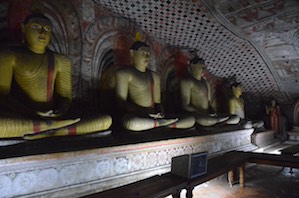
Next on the agenda was Dambulla. This is an ancient set of caves that are used as temples. We climbed the steps up the hill to the group of temples, walking barefoot around the complex and ducking into the caves to see the shrines. Although these are ancient sites, they are clearly frequently updated. The paintings on the walls date back to the 800s, but they are obscured by smoke and difficult to make out. They also are unprotected; you can walk right up and touch them, and they allow flash photography. One of the caves has painted fabric on the ceiling rather than painting, perhaps because the paintings are damaged, but possibly just because it was prettier. The statues are a mix, some several hundred years old (but with recent repairs) and some new. There is no distinction by age; all are venerated. The caves are of varying size, all crammed with multiple images of Buddha, including several reclining Buddhas. Outside there is a holy Bodhi tree and several lily ponds. It's a beautiful location, packed on this day with local pilgrims as it was a national holiday and many have come to give thanks. They often climb with flowers to present to Buddha, although after they leave the monks peremptorily cleared the flowers from the altars for the next round of pilgrims. No messy dropped leaves here.
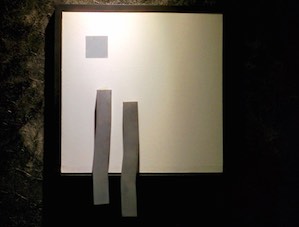
Our hotel for the night was a brand-new ecolodge in the country just outside the town of Habarana. This hotel is entirely elephant-themed. It's amazing; all the art, the lamps, the fabrics, the door handles, the keys, literally everything that can possibly be made to look like an elephant has been made into an elephant. There's even abstract art that is clearly...of an elephant. I love elephants, I really do, but I got to the point that I wondered if the chair I was using to email home had a trunk. The grounds were lovely, though, with a big open lawn dotted with herons and the rooms spread out in a series of small cottages such that you feel you have a little privacy and can enjoy your view of the lawns, the infinity pool, and the elephant lawn sculptures.
Save the Elephants!
Day 4: Anuradhapura

This morning dawned misty and warm, comfortable but depriving us of a view of the Sigiriya rock, which is typically visible from our hotel. We took it on faith at breakfast, but enjoyed the herons who nest on the grounds. Not FOR breakfast, you understand, but rather enjoyed them OVER breakfast. Important distinction.
This morning we took out jeeps to allow us to tour the small villages of this region, bumping along a collection of potholes occasionally interrupted by bits of road. We saw the crops, the houses, the schools, and the temples as we bumped by. We also saw some wildlife, particularly the abundant bird life including herons, cranes, weaver birds, and kingfisher. All lovely, and all attracted by the ripening rice crop. We stopped along the way to tour a school (cue children attempting to sing "Twinkle Twinkle Little Star"), and for a martial arts demonstration. The martial arts were interesting, but not very organized. It's never a good sign when the actors have to have a huddle to decide what to do next at the beginning of the show. Yak score: 4

The afternoon we spent at Anuradhapura, the capital of the island from 300 BC - 800 AD. This sprawling site was a huge city, supported by extensive man-made lakes and canals that allowed for agriculture and two crops a year of rice. Their ability to tame the monsoon rains led to the creation of this huge temple/palace complex. Many of the buildings and stupa fell into ruin as the capital moved to Polunnaruwa to the south, and by the time the British made it here in the mid-1800s all that was left was a small town and many intriguing heaps of brick under the jungle. There wasn't much excavation here for decades, but the temples closest to the modern town remained in use throughout the period. Over the last few decades the large brick-and-stone stupa have been rebuilt, and they are working to restore more and more of the buildings. The two large stupa would have been some of the largest buildings on earth at the time of their construction. Also of note is the Sri Maha Bodhi, a sacred Bodhi tree that is said to have been grown from a shoot of the Bodhi tree under which Buddha gained enlightenment. This came to the island over 2000 years ago and has been carefully maintained by a single family ever since that time. There is a massive shrine and temple surrounding the tree, and it is sheltered and protected by two dozen other Bodhi trees. Apparently the thought is that if there are any bugs or elephants or other predation on the way, they will leap in front of the sacred tree and sacrifice themselves? The tree's branches are supported by golden pillars that pierce the roof of the temple, placed where the tree needs them without regard for architecture.
As we wandered this complex and visited the sites that are available, the rains broke out with a vengence. Not cute little sprinkles, but flooding rain that you can't see through. Fortunately it wasn’t windy, and it remained warm, but we wound up totally soaked. Since we were also barefoot and hatless (one must be in the shrines), we wound up looking very pitiful. We survived, of course, and draped lots of dripping clothing all over the elephantine furniture of our lovely room. For the first time since arriving, I actually felt cold! And at least you can't get sunburned while swimming your way through temples.
Day 5: Sigiriya and Polunnaruwa

This morning we woke up after a long night of rain, but with the sun emerging from the clouds and all the trees dripping water as they slowly dried out. Our hiking clothes, made of that "quick drying" artificial cloth, had all dried overnight despite the ambient humidity of 98%, and we were surprisingly ready to go! This morning we headed to our second UNESCO world heritage site: Sigiriya, otherwise known as the lion rock.
The first capital of Sri Lanka was Anuradhapura, where we visited the day before. This capital became more vulnerable to attack from the South Indians, and so the capital moved further south to Polunnaruwa. In between those two, however, is the brief 18-year reign of Sigiriya. The story goes that the king had two sons who were half-brothers. One was his designated heir, but the other was jealous. After their father died, the jealous one, Karappa, deposed his half-brother, who then fled to India. Karappa built a capital city on top of a large rock, utterly impregnable. After 18 years, his half-brother returned from India to raise an army and take back his throne. Karappa came down from Sigiriya to lead his own army in defense. He was mounted on his great war elephant at the head of the troops, ready to lead the charge, when his elephant got distracted and started to turn away. His troops thought the king was retreating and surrendered. Karappa, humiliated, cut his own throat and died on the battlefield. The true heir regained his throne and chose to run his kingdom from the comfortable city of Polunnaruwa rather than on top of an inaccessible rock. The palace of Sigiriya was taken over by monks (who had been living there before the palace building craze). No one knows what happened to the distracted elephant, the clear hero of the story. I'm hoping rice balls and cashew trees for life. All of this happened around 800 AD. There are some things that make this interesting history unlikely, not least the fact that the top of Sigiriya, while spacious for being on top of a rock, seems a bit meagre for a capital city.
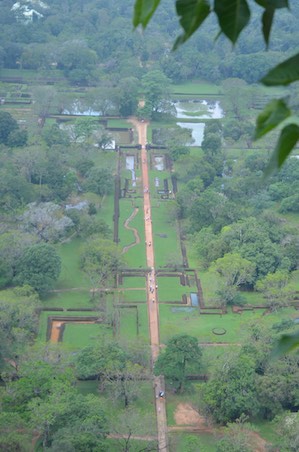
The approach to Sigiriya is fascinating, as there are several gardens along the approach. There is a formal geometric garden that looks like nothing so much as a French-style design with brick walks replacing the gravel ones, though sadly no conical trees. Next is a set of fountains, engineered such that they are powered by the reservoirs surrounding the city. After a heavy rain, the water can spray feet in the air from these fountains as water rushes into the reservoir. Given the rains yesterday, they were running the day of our visit but the water was only inches high. Finally there is the boulder garden, which we suspect is less purposeful ("let's make a meditation garden with lovely granite boulders") and more necessity ("Wow, these boulders are right in the way, but they are really heavy. Hey, look! It's a garden!")
The climb up the rock is via a series of staircases, many of these brick and stone of varying time periods. It was rather crowded, so the group climbed in a big queue with periods of halting and waiting. About a third of the way up, we took a brief detour up a spiral staircase to look at a series of murals of beautiful women. Exactly who these lovely women might be is unknown; they could be asparas, women of the court, somebody's pin-up wall, it is unknown. There were as many as 500 of them along the sides of the rock on white plastered sections, although only a dozen or so remain today. Just after the murals you find the "mirror wall", so called due to its finely finished plastering that almost reflects light. This has been the site of graffiti for almost 1500 years, presumably starting not long after the construction of the city. The early writings are lovely poems to the beauty of the women in the murals, but later it devolves into "Kilroy was here" or the Sinhala equivalent. Now of course even the Kilroys are carefully preserved historical landmarks.
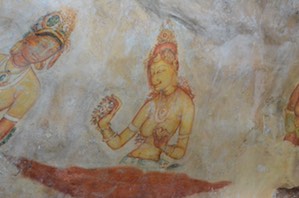
Shortly after the murals, we climbed further staircases to ascend to the lion's paws. At one point, there was a clearing facing the summit, with a giant brick lion's head facing you. The way upward was via a staircase between the lion's paws and into the lion's mouth. The lion's head has fallen down centuries ago, but the stone paws remain, as does the beginning of the old staircase. As you stand and look up, you see a somewhat rickety looking set of metal staircases snaking up the side of the rock, no lion head in sight. We continued upward, enjoying the creatively trimmed steel steps, and finally made it to the top. The palace/temple buildings are reduced to brick wall outlines and a few little pools, but you can visualize the layout of the community. There are water pipes running up to the site that provide water from the pools below, an impressive feat of engineering even now, much less in 800 AD. The views from the top of the rock are amazing, all the way to the mountains of the south. No one is sneaking up on this place. It's impressive, even if theoretically fueled by traitorous guilt.
As we climbed, we noticed a guy near us with a GoPro camera mounted on a selfie stick that was attached to his backpack strap, pointed directly at this face. While we appreciated his embrace of modern technology, I couldn’t help but notice that the photo-worthy part of this World Heritage Site was not actually a close-up of this guy’s sweaty face as he climbs stairs. I do not want to see that guy's You Tube channel. "Sweaty guy climbs Angkor Wat!". "Sweaty guy at the Temple of the Emerald Buddha". "Sweaty guy at Macchu Picchu, unusually cold". Ick.

There is a section of the stairs at Sigiriya that pass underneath several hornet's nests. There are big signs saying "loud noises may disturb the hornets" and they even have a few green metal cages where you can run and hide in case of hornet swarm. There are several makeshift medical stations at the site, which I assume specialize in EpiPens and ankle sprains. You might wonder why the hornets haven't been moved, particularly at such a popular and crowded tourist site. I mean, hornet stings will scare off even the most determined Go Pro guy (although "Sweaty guy being chased by hornets" might be pretty funny). Instead they take a typically Buddhist non-intervention approach, sending us off with the excellent advice: "Enjoy the climb, and don't worry about the hornets!". I'm going to add that to pretty much everything I say from now on. "Have a great dinner, and don't worry about the hornets!"
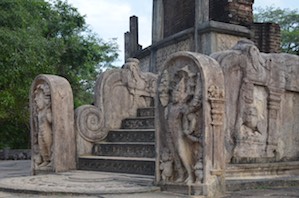
We descended, hot and tired after all that climbing in the sun, and headed toward our 2nd UNESCO site of the day (3rd overall), Polunnaruwa. This was the capital from roughly 800-1200AD, after the kings found that Anuradhapura was too prone to attack. During this period, there was a lot of interchange with the South Indian Chola kingdom, and in fact many of the queens of this era where Chola Hindus. For this reason, you start to see some Hindu temples tucked into the site among the many Buddhist shrines. The art and architecture is also very Indian influenced, and there are parts of Polunnaruwa that looks much like Chola sites. Other parts are entirely Sri Lankan, including the brick stupa design and the love of brick walks. Similar to Anuradhapura, much of the city is not fully excavated, and there is a modern town right in the midst of the ruins. After tramping around some of the ruins of the palace complex, we turned to a shrine in which there are four open-air Buddhas, ranging from standing to reclining. The reclining Buddha is particularly famed for the gorgeous lifelike artistic style. His face, his arms, his robes are realistic, and his pillow is dented where his head hits it. Gorgeous. Given the time of day, I was also a little jealous that he gets to nap, but then again I suppose he's the enlightened one for a reason.
After two UNESCO sites in one day (PHEW!) it was time for a little Lion Lager and dinner buffet. The local beers are all light lagers, typical of the Commonwealth, low in alcohol and good for hot climates. They come in 500cc bottles, but it's pretty easy to enjoy one at dinner without too much trouble, especially after sweating out pounds of electrolytes all day climbing rocks! It's inexpensive, usually 300 LKR for a bottle even at hotel markup, which is about $2.25. I looked forward to seeing the pub where the Lion Lager was originally brewed in the hills in a few days, and maybe even indulging in a draught pint. Lion Lager, good dhal, and a bizarrely tasty creme caramel later and it was time for us to emulate the Buddha and recline a bit. Still, I climbed the rock, where’s my lion?
According to the increasingly frantic emails I had been getting about clinic operations, Boston was at this point turning into Siberia and everyone was investing in reindeer and sleighs. I felt somehow guilty about being gone for the snow.
Day 6: Kandy

It was an early morning, as we left at 5:45 for a short elephant safari. Sri Lanka really is not a large place, and there are national parks all over the country. They are trying to preserve the Sri Lankan elephant, of which there are about 4000 in the wild on the island. Only about 7% of the males are tuskers, and they are as a whole much smaller than their Indian brethren. It is thought that this is due to hunting by the British, who valued shooting only the biggest, tuskiest, elephants and threw back the little ones. Harumph. To preserve the species, the government has set up national parks throughout the island, including some in areas that are intended for joint use by elephants and humans. There are villages in the parks, but the villagers are constrained not to shoot the animals. They have watchtowers and can scare them away, but nothing more traumatizing than some loud drumming is allowed. Fortunately the elephants haven't learned to rave, so it actually works. As a result, you can go on safari just off the main highway, which is a bit bizarre. You can't argue with the result, as during our short two hour drive we wound up stuck in a traffic jam after a herd of elephants decided to walk down the dirt road everyone was using. It was a standoff; a dozen elephants of varying ages and sizes against six jeeps and about 1000 cameras. The lead elephants tried to fake a charge and even trumpet a little, but they were easily calmed by the simple expedient of driving slowly toward them. In the end they decided they didn't like the road anyway and the bushes just off the road looked tasty. We spent a happy half-hour surrounded by chewing pachyderms while Steve noted that in fact the long zoom lens was not strictly necessary for this game drive. We came away with a lot of photos of parts of trunks.

After a well-deserved spicy omelette and tea, we departed the elephant-themed hotel and made our way toward Kandy, the second largest city on the island, central both geographically and commercially. It's not a long distance on the map, but took about 3 hours due to the constant road construction that narrowed the already insufficient two lane road. We stopped on the way at a spice garden and Ayurvedic medicine center where some of our group got to sample natural hair removal creams and other tonics. I bought some cinnamon, cloves, and cardamom, hoping they wouldn’t explode in my duffel or I would have wound up smelling like dessert. We had an amazing lunch of local specialties served on a balcony looking over a hillside. I can't name most of the local foods, as they all have very long multi-syllabic names that never seem to be written down anywhere. They are mostly based around local vegetables that don't really have English names. Whatever they are, they are amazing and the favors are dense and complicated and rarely overwhelmingly spicy. Plus, they provided three kinds of rice. What more could you want?
Given the long drive, we arrived in Kandy at the end of the day and didn’t really see much of the city. Our hotel was along the river, so we settled in to our room with a lovely view of a gigantic tree (bits of river could be seen around it) and then headed to a cultural dance show. This included a lot of drumming and rhythmic swaying, as well as beautiful costumes and lots of gold bangles. One of the dancing girls was clearly an understudy and didn't entirely know the routine, but the other one was very good. There was a strange comedy/clown bit in which one of the guys wore a big mask with mop string hair and laughed a lot. It might have been funny if you got the joke, but it mostly just looked like he'd gotten to the arrack before the show. It also included a lot of amazing acrobatics, spinning plates, fire walking, fire eating, and one really disturbing moment when one of the acrobats stuck thin wires through his cheeks so he could light them on fire next to his ears. (ew ew ew ew). This was a tough performance to grade, as the music (vaguely rhythmic drumming and off-tune chanting) and the comedy bit both scored high yaks. However, the acrobatics was genuinely cool and interesting. Then again, cheek wires (ew ew ew). Net net we're going with 5 yaks.
Day 7: Kandy

Kandy was the capital of the independent Kandy state for several hundred years, after the centralized kingdoms fell apart and until the British finally took over the entire island in the early 1800s. This last bastion of Ceylon rule was the home of the Tooth of the Buddha after Polunnaruwa fell and up to the present day. The Tooth is the holiest relic in Sri Lanka, enormously important to its people for 2500 years. This is the tooth of the Buddha, rescued from his cremation and preserved in Ceylon. At one point, the Chola kings looted the Tooth and took it back to India, but one of the daughters of the king hid it in her hair and brought it back to Ceylon. As kings battled, the Tooth was at times taken as booty, but always it was preserved and revered. It settled first in Anuradhapura then Polunnaruwa, and then finally in Kandy. In 1525ish the Portuguese captured the Tooth and took it to Goa, their city settlement in India. There they assembled several authorities and the local bishop and crushed the Tooth and tossed the resulting powder into the Indian Ocean. Fortunately the fragments of the Tooth reassembled themselves and flew to Kandy, where the intact Tooth was then revealed by the monks, safe and sound. It is said that if the Tooth leaves Sri Lanka, the country will be devastated and will fall into ruin. Whenever there is a disaster -- mudslides, typhoons, the 2004 tsunami -- the Tooth is called into action and special ceremonies held to ensure the safety of the nation. In 1989 the Tamil Tigers sent a suicide bomber who destroyed the front of the temple, sending the nation into a panic for a brief period. This is now entirely restored thanks to donations from other Buddhist countries who also revere the Tooth. It is not just a Sri Lankan relic; people come from around the world to see the Tooth. Witness the World Buddhism Museum just off the grounds, with exhibits and donations from every Buddhist nation.
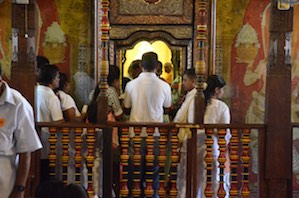
The Tooth is stored in 7 caskets, 6 of them gold and the outermost pure silver. 3 times a day the door of the inner temple is opened to allow the crowds to see the caskets (no one sees the actual Tooth, except on very special occasions). This is a total melee; we were crammed in with hundreds of people, pressed on all sides, desperate to get a glimpse of the shining casket as the crowds walk by. Once a year in August the caskets come out for the Kandy Perahera, an 11 day festival with every increasing numbers of dancers, drummers, pipers, and elephants. By the last day, there are 300 elephants marching in an all-day parade. Most famous is the Tusker who carries the Tooth casket. For 60 years this was Rajah, a famed tusker who lived in the temple. He sickened in the mid-80s and was treated by the best veterinarians and doctors, given better care than most humans. He unfortunately died and was then stuffed; his remains are preserved next to the Temple in a shrine of their own, surrounded by photos of his life and the many prime ministers and presidents who came to visit him at the temple. When he died there was a national day of mourning. (Did we mention that this is a country that REALLY LOVES elephants?) There is now a new tusker designated to carry the Tooth caskets each year, and he is equally revered and no doubt is also visited by dignitaries who feed him only the best pineapples.
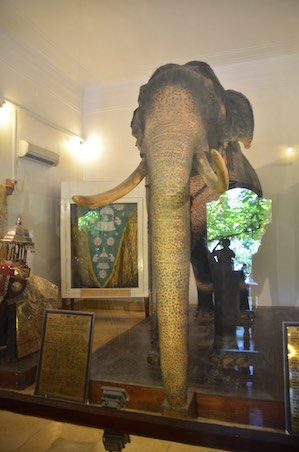
After surviving the melee of the Tooth presentation, we wandered the complex for a couple of hours, enjoying the lovely architecture and the setting along the lake. There is a grand old colonial British hotel (The Queen's) across the street, and an Anglican church right next to the grounds, evidence of the British takeover of this district after the surrender of the last Kandyan king. Kandy is the second largest city in Sri Lanka and is very much a mercantile center. It is also the center of the gems trade in the country, and jewelers of varying skill and honesty can be found on every corner. Sri Lankan sapphires and rubies are particularly renowned.
Interestingly, there is a population of Muslim traders in this region who organize and run the spice trade (and other related commercial enterprises), including a good chunk of the gems trade. This group descended from Arab traders and they settled here to be close to the source of their product. One town, Matale, is clearly Muslim majority with a huge mosque, Arabic on all the signs, and women in niqab and black robes on every corner. Sri Lanka is about 10% Muslim, but it does seem that they are concentrated in centers like these, and perhaps in certain roles or industries. The center of Kandy seems mostly Sinhalese, although there is a small Tamil/Hindu minority witnessed by the small Hindu shrines dotted here and there. It is a melting pot of a country.
After enjoying the Temple of the Tooth (UNESCO site # 4), we retired for an afternoon of rest in our hotel. We had a quiet few hours at the open-air bar, watching the river roll by and the Australians bake in the swimming pool. Birds flew by and landed in the nearby trees. We checked the weather forecast and saw that Boston was heading toward foot #5 of snow, an historic total. Steve was actually pining for it, he was sad that he was missing all the snow fun. I sipped my Singapore Sling and nodded sympathetically.
Enjoy the shoveling, and don't worry about the hornets!
Day 8: Highlands

We left Kandy and the lowlands and headed into the hills, preparing for our upcoming ascent of Adam's Peak/Sri Pada. Along the way, we saw three very interesting Buddhist/Hindu combination temples in the countryside. These date to the period around 1400-1500, and were built by a neighboring kingdom to Kandy. This kingdom embraced equality between the two religions to the point that it became common to build temple complexes with shrines to each religion next to each other -- a Shiva temple next to a Buddhist shrine, and a Bodhi tree in the yard. Some of the imagery is a bit muddled for this reason, with Buddha having some very Hindu-looking deities in attendance and quite a lot of Bodhi trees in the paintings of Vishnu. Of course, the Buddhists believe that Vishnu, like Jesus, Moses, and Abraham, was but one of the many other enlightened prophets, so they have no problem with the Hindu gods. Similarly, many Hindus believe that Buddha was an incarnation or aspect of Krishna, so they don't mind much either. There aren't any mosques in this happy picture, but at least these two groups were getting along well at the time. (Tamil Tigers aside, that seems to have been the historic norm in this country.)
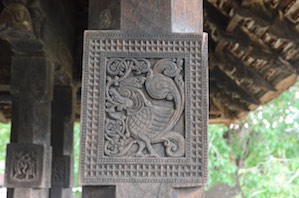
The carvings on one of these temples showed some other influences. There is a distinct carving of a Western warrior in armor on horseback, which apparently is a Portuguese fighter. The Portuguese colonized large chunks of the Western coast of Sri Lanka in 1505, holding on to this for 150 years until the Dutch took over, who then ceded to the English in the early 1800s. Plenty of opportunities for Western "cultural exchange"...
These temples are up in the hills, on a narrow road that barely deserves to be called single lane. The best way to get there is by tuktuk, so we formed a caravan of them (which begs the question, what do you call a group of tuktuks? A tribe? A swarm? A cylinder?). These little guys are great for short journeys, but they do at times struggle on the bumpy road, particularly on the steeper uphills. There's no danger of getting out to push, though, so it was all fine. It's certainly an atmospheric way of seeing the countryside.

The afternoon was spent driving ever uphill on the winding switchback roads to the tiny town of Dalhousie (yes, really), the trailhead for the hike to Adam's Peak/Sri Pada. This is the 5th highest mountain on the island, about 7359 feet elevation. The climb has a gain of 2800, and a temperature drop from 75 degrees to 45! (I know, Boston was 2, I shouldn’t complain.) The goal is to reach the summit in time for sunrise, as the top is a holy site with a depression thought to be the footprint of Buddha/Siva/St Thomas/Adam (depending on your religious tradition). Pilgrims come from all over the country to do the climb, and in fact much like the Hajj to Mecca the Buddhists of Sri Lanka consider this a necessary part of their faith to climb at least once.

Speaking of tea, I have to confess that my already near-religious zeal for the beverage was only encouraged in this country of tea growers. The English initially grew coffee here, but after a blight they had to switch crops and moved to tea, with the plants imported from India. Ceylon tea is of course well known worldwide, largely thanks to the enterprising Thomas Lipton, a Scottish entrepreneur who decided to buy plantations in Ceylon to source tea for his chain of grocery stores in the UK. He then invented the teabag as a way of making tea affordable for the masses, creating a brand that is of course going very strong today. The result in the present day is that the coffee drunk in this country is uniformly horrible Nescafe instant coffee, the blight of world travelers on every continent. However, excellent well-brewed tea is available everywhere. At our elephant-themed Aliya hotel, they brewed lovely tea at breakfast, although unfortunately the service wasn't always very brisk. After waiting almost 30 minutes for my morning caffeine, I finally picked up my cup and walked back to the serving area and asked plaintively for just a little. I then became infamous among the staff, and at every meal for two days the waitstaff would ask me "more tea, ma'am?", "did you need some tea this evening?" and even "I know you like tea". Always with a big smile and a laugh, very funny and I certainly deserved a little ribbing. On the way to Dalhousie we drove into tea country, and kept passing tea estates, every hill covered in plants with the workers in colorful saris walking among the plants, picking leaves. There were estate-owned tea houses all along the road to sell snacks and beverages but also to sell their many types of tea. There are fruit flavored teas, green teas, white teas, estate teas, ayurvedic teas, organically grown teas, and several grades of black Ceylon Orange Pekoe tea. We stopped in the mid-afternoon at one such tea shop with a gigantic statue of a teacup in the lawn as their sign. For 40 rupees (about 30 cents) I got a perfect cup of black tea and the use of a scrupulously clean restroom. This may be the best country ever.
Day 9: Adam’s Peak

Adam's Peak. It's big, it's pointy, it's tall, and it's time to climb it! We got in to a very basic but fun guesthouse (Slightly Chilled, in both name and demeanor), and after figuring out how to turn on the hot water boiler got showered and ready for the hike. Steve pointed out that the boiler was only slightly helpful, as it produced water that while it was acquainted with hot water, and possibly even Facebook friends with hot water, didn't actually know hot water very well in real life. Still, it wasn't frankly *cold*, so I still counted it a win. A very simple but filling dinner later, we climbed into bed at 9pm to get a few hours sleep before our alarms went off at 1:45am. By 2:45am we were up and out, on the trail to the peak. This is a 2800 foot elevation climb that is 4.5 miles long (each way). It is the best kept hiking trail I have ever seen. The entire stretch of trail, all 4.5 miles, is cement, often as much as 10 feet wide, with steps most of the way. Since you typically hike at night, there are big street lights the entire way up. Tea shops exist on every vaguely flat bit of land, all lit up and blaring Bollywood music. They sell cold drinks, biscuits, fruit, and later in the morning hot roti and other snacks. At the base of the hill there's actually a shopping mall of all kinds of stalls, in case you needed a plastic vase or an inflatable penguin balloon. (Presumably you buy these on the way down?)
In any event, it was 3 very UP hours of climbing. It started out slow, with a winding trail through the forest, interrupted by Buddha shrines and meandering along a river. We thought, oh, this is so pleasant and enjoyable. The short flights of stairs were just a nice challenge. Even at 3am it was warm and humid, so it wasn’t the most comfortable hiking weather, but surely it would improve as we climbed. Speaking of climbing, we then hit a section of staircases, essentially nothing but concrete steps of varying height and width winding into the distance. They weren't too steep, though, and you could continue upward with some pauses to drink water and catch your breath. We stopped about halfway up for a little pack breakfast; boiled eggs and bananas, a little chocolate, good hiking food. Then we continued ever upward. Not too much longer we got to the third part of the hike, an endless series of wickedly steep, narrow steps that just kept going relentlessly into the night. There are metal handrails on either side, necessary not to keep you from falling but rather to give you something to hang on to as you heave yourself upward. The steps are a foot or more high, but uneven, so you can't really get a rhythm and especially in the dark you have to look for each one. Every now and then there's a surprise -- an eroded step, some dirt, a small dog -- and you have to really pay attention. The air was slightly cooler but the effort involved in climbing was such that we were both overheated, and the 1000% humidity meant we were quite...damp. I got to the point I seriously wondered if my legs will make it any further when a helpful tea shop owner told us it's only 300 more meters, 552 steps! Oh, yay. The tea shops are a blessing, and they don't push you to buy things, they are really lovely. We dragged ourselves up a little more of the cliff and finally saw the end! A shining golden temple surrounded by masses of humanity.

Just before the top, a nice Sri Lankan police officer stopped us to give us security advice. Keep your valuables close to your body, wear your backpack in the front, take off your shoes but carry them with you, etc. They keep watch, but there are thefts at the top despite their efforts. He was really nice and very helpful, and the several police stations along the path add to the tremendous organization of the place. We pushed our way through the crowds at the top of the stairs and finally got to the shrine at the top. Boots off but firmly in our hands, we were able to see the shrine at the footstep of Buddha/Shiva/Adam/St Thomas. We couldn’t actually see the footstep itself, as there was a puja underway with drums and pipes and priests coming and going. You aren’t allowed to photograph the temple, it is so holy. So just take my word for it that it is pretty and golden and has a lot of decoration. We rang the bell to indicate that we made it to the top, achieving some merit for our next life, and enjoying the booming sound across the valley. The views of the lake, hills, and village were absolutely amazing, although of course we did have to pay a bit to get them!
After a while, we started the descent in the burgeoning dawn. Unfortunately due to the cloud cover the sunrise wasn’t very interesting, but we did notice that we could finally see! The very slight cool spot on top of the mountain rapidly warmed in the sun, and we put on our boots and hats and prepared for the descent in the growing heat, still with 1000% humidity. It was a quick descent by schedule necessity, but we raced down in 2 hours flat, trying not to torture our knees too much on the incessant steps. Our new collapsible hiking poles worked *fabulously* and didn't slip even after 6 hours of punishment. Black Diamonds for the win. We made it back to the hotel just after 8:30, absolutely soaked in sweat (sorry, but it's true, it was terrible) and weak of leg, but triumphant! According to Steve’s phone, we met our daily Fitness Goals by 3:12am, is that good?

Almost immediately on arrival we drove to Horton, a nearby town, to pick up the train to Nuwara Eliya. This town in the hills was a British colonial hill station and center of the tea plantations. The climate is cool and fresh (THANK YOU) and there was a gentle rain falling as we arrived, enough to make everything sparkle. The town is a rather bizarre mix of Victorian English Countryside, complete with half-timbered houses and gingerbread on every porch, and Sri Lanka. The hills are covered in tea plants, very green in the sun, with women in colorful saris plucking the leaves. The houses could have been transported from some Kent village, but they have bullocks in the yard and tuktuks driving by. It's rather odd, but fun. Our hotel extended the theme, a determinedly British hotel complete with wood-paneled bar with fireplace, a snooker room with 3 gorgeous tables and spectator seating, a cigar humidor, a golf course, and a dress code for dinner. It's amazing. Weird, but amazing.
This afternoon after a much-deserved meal of amazing Thai food and a much-enjoyed shower, we headed to a tea plantation to learn about the processing of Ceylon tea. This was in fact the first tea plantation founded in Ceylon by James Taylor (not that one). They have been in production with some of the same equipment since the mid-1850s. It's very much a handicraft, from the plucking to the drying, rolling, drying and packing, all done with a few basic machines and a lot of hand labor. It was fascinating and the air was redolent with roasting tea, which you can imagine sent me into a state of near-hallucinogenic delight. Of course, the fact I was staggering with fatigue also helped. They even served us a lovely cup of estate tea after the tour. I nearly refused to leave.
Before dinner we relaxed in the very English pub of the hotel, next to a roaring fire (not kidding). We enjoyed a little celebratory drink for our climb this morning, and enjoyed deviled cashews along with draft Lion Lager.
Day 10: Horton Plains, World’s End

Another cool and misty morning dawned in Nuwara Eliya, and we gratefully opened the windows of our room to look out on the manicured lawns and topiary of the hotel. After a brief fortifying breakfast (more wood apple juice and fresh pineapple), we struck out to the nearby Horton Plains national park (World Heritage Site #6). This large national park in the southern central part of the country is in the plateau, but it includes something ominously called World's End, a place where you can see the escarpment that marks the abrupt end of the plateau and the drop off to the lowlands and the Indian Ocean to the south.
We had a nice three hour hike through the park, not very challenging compared to yesterday's climb, but more than enough to wake up some rather sore quads and calf muscles. The path wanders through woods, grasslands, and up and down hills, so you can enjoy the beautiful countryside. We turned a corner and suddenly came to World's End, which really does look like the point at which the flat earth drops away to nothingness. There was mist on the hills that swirled down the escarpment and filled the valley below with thick white cloud cover, such that we seemed to be floating above the world. We could just see a few ghost trees sticking up from the side of the cliff below. It's incredibly dramatic, and someone is doing a great job with the fog machine because it really does make the scene. Naturally there are no safety rails (OSHA does not exist in most of the world, thankfully), so you can climb right to the edge and look down (carefully). Gorgeous.

There is also Mini World's End, which honestly doesn’t seem to be Mini, but is just as cool as the real thing. Maybe if you can see to the bottom of the valley the drop off is less impressive? We hiked further on through the woods, now convinced that we were floating on a cloud island. A bit further on is the small but lovely Baker's Falls, on this morning particularly nice as the recent rains fed the streams and lakes in the hills. Not long after leaving the falls we got to sample some of this precipitation, but really only a sprinkle to cool us off on our hike; unlike the climb the day was warm not hot and there was a cool breeze. The comparison between hikes was clear: I give Adam's Peak at least 7 myocytes, and Horton Plains no more than 2. By the time we finished we actually fully warmed up and our legs no longer hurt!
Interestingly, there used to be many elephant herds in this lovely paradise of a plateau. You could see that they would love the cool greenery, the abundant trees for scratching against, the little river for wallowing, and the gentle rolling hills. Unfortunately proximitiy to the hill towns meant that this was also a prime hunting area for the British, with the inevitable result on the herds. There are no elephants here now, only smaller mammals and birds. I don't think the name Horton Plains has anything to do with the pachyderms, but given the elephatine nature of the country I can't really say for sure. Horton and his Whos would really like this place if given the chance. Who knows, maybe in future they'll relocate some of the elephant herds here, similar to the projects they have in Southern Africa.
After a quick and uninspiring box lunch, we returned to our hotel for a shower and restorative cup of tea. We had 5 or 6 box lunches, and they were all identical -- a hard boiled egg, a cheese sandwich on white bread with the crusts carefully removed, a chicken leg, a couple slices of pineapple, a banana, and sometimes watermelon. We call this Western Standard Meal #7. Sometimes we got Western Standard Meal #7A, in which they add tomato to the cheese sandwich. That's the deluxe version. I longed for samosas and roti.
In the afternoon we walked just off the hotel grounds to the private Hill Club, a bastion of English male society, for High Tea. In the tradition of exclusive English clubs, the food was terrible, and even the tea was pretty poor. The setting, however, is even more determinedly Victorian traditional than our hotel, which is amazing! Their device is a leopard, which is reflected in a collection of leopard photos taken by members hanging on the walls. Unfortunately none are as up close and personal as the tiger that was shot in the billiard room at Raffles Hotel in Singapore, my personal standard for best metaphorical moment in Raj history.
Day 11: Yala
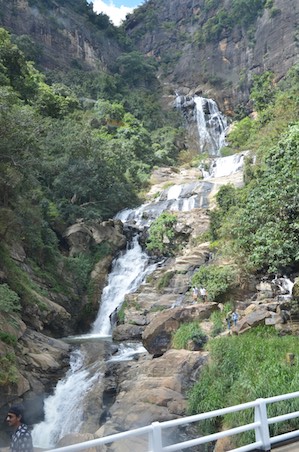
We enjoyed our second cool and slightly rainy night in the Grand Hotel, soaking in the lack of heat, and drinking lots of local tea. In the morning we set out on a six hour drive to the southeastern coast and Yala National Park. The first part of the drive is in the hills, lots of switchbacks and tea plantations in the cool mist. Then we once again found the escarpment, now less in cliff form, and descended for what seemed like forever down a hillside road. Along the way we saw the famed Ravena Falls, which feature in the Ramayana stories. We also stopped at a Hindu temple that is at the site of the "monkey's paws", two depressions in the rock next to a stream that are reputed to be the site where Ravana imprisoned Sita during the tale. These literary milestones provided a welcome break from the narrow and somewhat harrowing road. At last we reached the southern plain, and the agriculture switched from tea and vegetables to rice paddies as far as the eye can see. Another couple of hours in the growing heat and humidity and we were at the coast, all palm trees and tropical sand dunes.
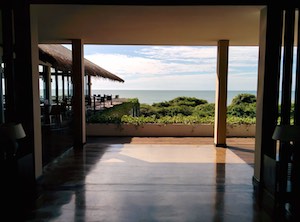
Our hotel was directly on the Indian Ocean, with gorgeous water views, and also was on the grounds of the Yala National Park. As we drove in (beware road construction, naturally), we saw water buffalo, wild pig, several storks, and a mongoose crossing the road. The hotel itself is surrounded by an electric fence to keep out the elephants. It's a stunning property, just a year old and with a beautiful open design that makes the most of the setting and the soft sea air. Our room had a private balcony looking out on the dunes and the ocean, and the bathroom was partially open air, with a little garden just outside the shower so that it felt like you were showering outside! There was even a separate shower nozzle that looks like a drainspout that provides rainwater from the roof tank. After our long drive, we decided to drop off our bags and retired to the open air hotel bar to watch the waves roll in and enjoy the warmth with a cold Coke/Lion Lager.

Shortly after finishing our drinks, we were refreshed and ready to depart for our first safari in the park. We climbed aboard the safari trucks and had a lovely three hour safari through the park, starting directly from our hotel, during which we saw all kinds of birds, including a flock of pelicans crashlanding in front of us, sambar deer, spotted deer, wild pig, several elephants, and a bush that was reputed to have a leopard sleeping underneath. The only thing spotted that I spotted was the deer, so I can't substantiate the leopard. The sun rapidly dropped from the sky and we drove back to the hotel, happily talking about elephants and the view of the ocean. For dinner we were treated to a beach cookout with local fish grilled to order and other delicacies. When we walked down, we were told that an elephant had just walked down the beach through our dining area, and in fact you could still see his footprints. I quibble with the effectiveness of those fences! However, this probably explained the utter lack of cashew or peanut based deserts on the buffet. Fortunately the leopards didn't find out about the local pork that was being grilled to order, or we might have had a second visitor.
Day 12: Yala
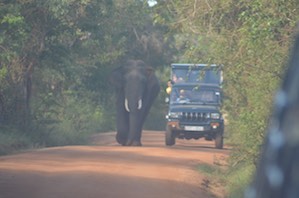
We woke before 5am for our second safari. We drove around the same part of the park, and this time in the cool (ok, 75-80 degree) air we saw many more animals than in the afternoon heat the day before. We saw a tusker standing on top of a rock, as though he thought he was a lion. He seemed to like the vantage point this gave him to demolish the tall tree next to the rock, and he's got the tusks, so really he can do whatever he wants. We saw several more wild elephants near the trail, and at one point another tusker was walking down the trail toward a set of jeeps who very rapidly backed away to give him some room. Unlike the elephants in the center of the island, these will attack if provoked. I was therefore a little surprised when our driver decided after backing up for a while to stop, and then drive forward really fast passing right next to the elephant. We were about 2 feet from those big tusks, and he looked a little surprised to see us. We made it out unpunctured, fortunately, as we were too quick for him. Almost at the end of our drive, we finally found the animal we came here to see -- the elusive leopard! There are about 2000 of them in Yala, really the only place they are found on the island. Although certainly endangered, the controls here are good enough that there is not much poaching and they can lead a quiet and wild pig-full life. This leopard was, true to form, draped over a branch looking entirely bored. Still, we managed in two short game drives to see 8 elephants, 2 of them tuskers, and 1 leopard. Impressive! All of this on the shores of the ocean with the palm trees swaying and the waves crashing in the background. Seriously, this may be the most perfect country in the world.

After breakfast and a last lounge in the swing chair in the lobby it was time to leave the beach/safari portion of our trip and head to Galle. Our drive took us along the southern coast highway, with the ocean constantly to our left. It's a beautiful four-hour drive and the ocean is lovely, but it's clear that everything along the way is new construction. There is a very good reason for that -- this coast was devastated in the 2004 tsunami, in which tens of thousands of people from Sri Lanka died. Every place we stopped had a set of photos of the surrounding area after the storm, fishing boats resting on top of the remains of houses, palm trees standing alone among debris. One of the reasons for the stretch of recent beach-front luxury hotels in Yala is the use of redevelopment funds from the tsunami to create a tourism industry here. It might seem counter-intuitive to use funds from a tsunami to build lots of expensive beachfront properties, but tsunamis are incredibly rare and the influx of money into this section of the country has been very necessary. In fact, the government is reluctant to limit the tickets to the national park as it is such a cash cow for the local villages, but it is getting crowded and environmentalists are starting to introduce bills in congress to limit the number of visitors. The leopards remain bored.

Our hotel near Galle is a gorgeous building designed by Geoffrey Bawa, a famed local architect. It is a combination of Sinhalese and Moorish architecture, and features a fabulous staircase with metal sculptures depicting the Portuguese landing. It’s an unfortunate part of history, and a somewhat violent depiction, so I found myself rooting for the local leopards in mid-mauling of the European invaders. The artwork is astonishing, and we found ourselves challenged to capture it on film, as each time we came through the light was different and we saw more of the scene.
Day 13: Galle

Galle was a major port on the island prior to the arrival of the Portuguese, and with their arrival became even more prominent. The Portuguese started the fort city, and it was later expanded by the Dutch, then transferred to British control when they took over the island. It is the largest remaining fortress city built by Westerners in Asia, and much of the city is beautifully preserved. The city’s ramparts overlook the Ocean, and the famous lighthouse guards the southern edge of the fort. There are churches, mosques, Buddhist and Hindu temples in the city, interspersed with houses and shops. In some ways, it reminded me of downtown Charleston, many of the buildings from the same era, and the same emphasis on keeping the old city alive without changing its character. We enjoyed wandering the town, stepping into shops and eating snacks as we went. As we walked the ramparts, we passed a group from a local girls school, the students in bright white dresses and long ponytails. We were stopped by a film crew using the old Dutch church as a backdrop, although we were able to sneak past long enough to see the stone memorials that lined the floor and walls.
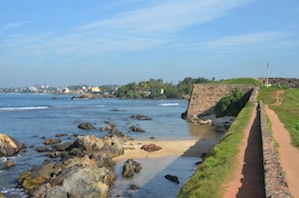
Unfortunately our time in this wonderful country came to a close, and after an amazing dinner we spent the evening packing while watching the sun set over the ocean. Our room’s balcony was separated from the waves by only a few hardy palm trees and a scant foot of rocky beach, and the ocean seemed to be our very own. A few hours later we were awoken by a text from British Airways – our flight from London to Boston was cancelled due to the perpetual blizzards. We had been following the historic snowfalls remotely, chuckling at our good fortune to be in the tropics instead of suffering at home. It was tempting to see this as a sign that we should just stay in Galle, eating rice and curry and enjoying the soft breezes. Steve insisted this wasn’t possible, and made me get in the car to the Colombo airport. We rebooked our flight home, but on arrival to Dubai received another text from BA with another cancellation. By the time we got to Heathrow we had been on four or five different flights, and then somehow next found ourselves in Philadelphia. Thanks to American, who saw us through all the changes, we dragged our duffels and ourselves through the freezing cold toward the culture shock of a Courtyard by Marriott. When we finally got ourselves back to Boston the next morning, we were shocked to find our car under six feet of snow, a Volvo igloo of sorts. We spent the next few days shoveling off the roof and wishing in vain for a nice elephant to come by and rescue us, missing the many wonders of Sri Lanka.